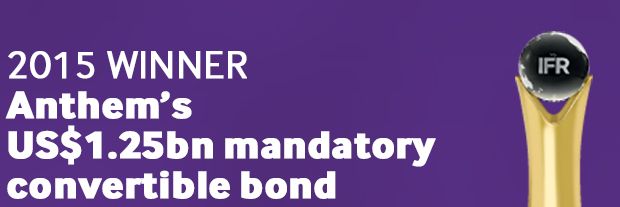Rousing tune
A convertible bond deep in the money should be a cause for celebration, marking the success of management in outperforming and significantly increasing a company’s share price. Yet the enormous success can be a cause of concern when managing future finances.
US health insurer Anthem found itself in a potentially precarious situation in early 2015 with a US$3bn cash call that could come at any time.
The company’s US$1.5bn principal 2.75% 30-year CB issued in 2012 (when the company was called Wellpoint) was the cause of concern. The conversion price was US$75.58 but the shares had since risen to US$154.20. With the bonds trading at 207, early conversion was a real risk.
“Conversion would have brought about a potential liquidity event we would not have wanted,” said Anthem VP of corporate finance Merrill Yarling. “It was a potential put, at their choice and not ours.” The bonds are not callable until 2022.
A net-share settlement structure meant Anthem had to fund the principal in cash and use cash or stock for the remaining value – and make that decision within 24 hours of notice. The shareholder-friendly option of full cash settlement would create a nearly US$3bn cash call for just half of the outstanding.
Liability management on CBs was a common theme of the capital markets in 2015, though none dealt with the problem as elegantly as Anthem.
The solution for Anthem, rated Baa2/A–, was a US$1.25bn mandatory convertible that allowed it to raise a significant amount of capital through a security that provided both partial equity credit and tax efficiencies and to negotiate a price to purchase half of the outstanding bonds.
Key to success was to maintain tension on both the price paid for the 2042s and terms on the new MCB. Initially a 1–1.25 point premium was offered on the existing bonds, before pricing the purchase of US$700.5m principal at 0.875 points above parity.
Management was still concerned about dilution, despite how far the stock had already risen. To achieve a higher upper conversion threshold of 30%, Anthem agreed to compensate investors for up to a 10% drop in its share price.
“We were bullish on where we thought our stock price would be three years out,” said Yarling.
Anthem reached agreement in July to acquire rival Cigna for US$54.2bn, including assumed debt.
Credit Suisse, which was joined by Bank of America Merrill Lynch as a bookrunner, set the coupon at 5.75%, a 415bp pick-up to the yield on the underlying at the time. The banks increased the base deal from US$900m at launch to US$1.175bn, and subsequently exercised their US$75m overallotment option.
To see the digital version of the IFR Americas Review of the Year, please click here .
To purchase printed copies or a PDF of this report, please email gloria.balbastro@tr.com .
